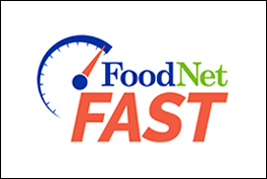2018 Preliminary Data: Tables
Documenting the major sources of and trends in foodborne illness provides important information needed to determine whether prevention measures are working. Each year, FoodNet reports on the number of infections in the FoodNet surveillance area from pathogens transmitted commonly through food. Laboratory tests, including cultures for bacteria and culture-independent diagnostic tests (CIDTs) detected these pathogens.
This year’s report summarizes 2018 preliminary surveillance data and describes 2018 incidence compared with 2015–2017 for infections caused by Campylobacter, Cyclospora, Listeria, Salmonella, Shiga toxin-producing Escherichia coli (STEC), Shigella, Vibrio, and Yersinia. The report also summarizes cases of hemolytic uremic syndrome (HUS) for 2017.
Incidence trends
FoodNet uses a main-effects, log-linear Poisson regression (negative binomial) model to estimate changes in the incidence of infection.
FoodNet uses a main-effects, log-linear Poisson regression (negative binomial) model to estimate changes in the incidence of infection. The model adjusts for the increase in the number of FoodNet sites since 1996 and for variation in the incidence of infections among sites. The average annual incidence for 2015-2017 is used for comparisons. The model is used to calculate the estimated change in incidence (relative rate) between 2018 and the comparison periods, with 95% confidence intervals (CIs).
| Serotype | % Change in Incidence† | (95% CI) |
|---|---|---|
| Enteritidis | -10% | (-22% to 5%) |
| Newport | +10% | (-8% to +33%) |
| Typhimurium | +4% | (-9% to +17%) |
*Data for 2018 are preliminary.
†Percentage change reported as increase (+) or decrease (-). Significant changes indicated in bold.
| Serotype | % Change in Incidence† | (95% CI) |
|---|---|---|
| O157 | -12% | (-27% to +7%) |
| non-O157 | +25% | (+9% to +44%) |
*Data for 2018 are preliminary.
†Percentage change reported as increase (+) or decrease (-). Significant changes indicated in bold.
| Age Group | % Change in Incidence Rate† | (95% CI) |
|---|---|---|
| <18 years of age | -16% | (-38% to +14%) |
| <5 years of age | +3% | (-30% to +50%) |
*Data for 2017 are preliminary.
†Percentage change reported as increase (+) or decrease (-).
Correction for Figure 1 STEC Graph in MMWR
The correction has been published in an erratum.
